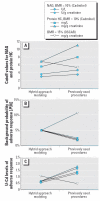Benchmark dose for cadmium-induced renal effects in humans
- PMID: 16835061
- PMCID: PMC1513341
- DOI: 10.1289/ehp.9028
Benchmark dose for cadmium-induced renal effects in humans
Abstract
Objectives: Our goal in this study was to explore the use of a hybrid approach to calculate benchmark doses (BMDs) and their 95% lower confidence bounds (BMDLs) for renal effects of cadmium in a population with low environmental exposure.
Methods: Morning urine and blood samples were collected from 820 Swedish women 53-64 years of age. We measured urinary cadmium (U-Cd) and tubular effect markers [N-acetyl-beta-d-glucosaminidase (NAG) and human complex-forming protein (protein HC) ] in 790 women and estimated glomerular filtration rate (GFR; based on serum cystatin C) in 700 women. Age, body mass index, use of nonsteroidal anti-inflammatory drugs, and blood lead levels were used as covariates for estimated GFR. BMDs/BMDLs corresponding to an additional risk (benchmark response) of 5 or 10% were calculated (the background risk at zero exposure was set to 5%) . The results were compared with the estimated critical concentrations obtained by applying logistic models used in previous studies on the present data.
Results: For both NAG and protein HC, the BMDs (BMDLs) of U-Cd were 0.5-1.1 (0.4-0.8) microg/L (adjusted for specific gravity of 1.015 g/mL) and 0.6-1.1 (0.5-0.8) microg/g creatinine. For estimated GFR, the BMDs (BMDLs) were 0.8-1.3 (0.5-0.9) microg/L adjusted for specific gravity and 1.1-1.8 (0.7-1.2) microg/g creatinine.
Conclusion: The obtained benchmark doses of U-Cd were lower than the critical concentrations previously reported. The critical dose level for glomerular effects was only slightly higher than that for tubular effects. We suggest that the hybrid approach is more appropriate for estimation of the critical U-Cd concentration, because the choice of cutoff values in logistic models largely influenced the obtained critical U-Cd.
Figures


Similar articles
-
Risk assessment for Thai population: benchmark dose of urinary and blood cadmium levels for renal effects by hybrid approach of inhabitants living in polluted and non-polluted areas in Thailand.BMC Public Health. 2014 Jul 9;14:702. doi: 10.1186/1471-2458-14-702. BMC Public Health. 2014. PMID: 25012790 Free PMC article.
-
Benchmark dose estimation for cadmium-induced renal tubular damage among environmental cadmium-exposed women aged 35-54 years in two counties of China.PLoS One. 2014 Dec 23;9(12):e115794. doi: 10.1371/journal.pone.0115794. eCollection 2014. PLoS One. 2014. PMID: 25536107 Free PMC article.
-
Estimation of benchmark dose as the threshold levels of urinary cadmium, based on excretion of total protein, beta2-microglobulin, and N-acetyl-beta-D-glucosaminidase in cadmium nonpolluted regions in Japan.Environ Res. 2006 Jul;101(3):401-6. doi: 10.1016/j.envres.2005.12.002. Epub 2006 Jan 24. Environ Res. 2006. PMID: 16436274
-
Recent applications of benchmark dose method for estimation of reference cadmium exposure for renal effects in man.Toxicol Lett. 2010 Sep 15;198(1):40-3. doi: 10.1016/j.toxlet.2010.04.015. Epub 2010 Apr 24. Toxicol Lett. 2010. PMID: 20420885 Review.
-
Usefulness of biomarkers of exposure to inorganic mercury, lead, or cadmium in controlling occupational and environmental risks of nephrotoxicity.Ren Fail. 1999 May-Jul;21(3-4):251-62. doi: 10.3109/08860229909085087. Ren Fail. 1999. PMID: 10416202 Review.
Cited by
-
The physiological determinants of low-level urine cadmium: an assessment in a cross-sectional study among schoolchildren.Environ Health. 2017 Sep 12;16(1):99. doi: 10.1186/s12940-017-0306-5. Environ Health. 2017. PMID: 28899425 Free PMC article.
-
Environmental cadmium exposure and osteoporosis: a review.Int J Public Health. 2013 Oct;58(5):737-45. doi: 10.1007/s00038-013-0488-8. Epub 2013 Jul 23. Int J Public Health. 2013. PMID: 23877535 Review.
-
Prenatal cadmium exposure and preterm low birth weight in China.J Expo Sci Environ Epidemiol. 2017 Sep;27(5):491-496. doi: 10.1038/jes.2016.41. Epub 2016 Jul 20. J Expo Sci Environ Epidemiol. 2017. PMID: 27436694
-
Non-renal effects and the risk assessment of environmental cadmium exposure.Environ Health Perspect. 2014 May;122(5):431-8. doi: 10.1289/ehp.1307110. Epub 2014 Feb 25. Environ Health Perspect. 2014. PMID: 24569905 Free PMC article. Review.
-
Electronic Cigarette-Derived Metals: Exposure and Health Risks in Vapers.Chem Res Toxicol. 2025 Apr 21;38(4):542-556. doi: 10.1021/acs.chemrestox.4c00520. Epub 2025 Mar 17. Chem Res Toxicol. 2025. PMID: 40094421 Review.
References
-
- Bernard A, Roels H, Buchet JP, Cardenas A, Lauwerys R. Cadmium and health: the Belgian experience. IARC Sci Publ. 1992;118:15–33. - PubMed
-
- Buchet JP, Lauwerys R, Roels H, Bernard A, Bruaux P, Claeys F, et al. Renal effects of cadmium body burden of the general population. Lancet. 1990;336(8717):699–702. - PubMed
-
- Buchet JP, Roels H, Bernard A, Lauwerys R. Assessment of renal function of workers exposed to inorganic lead, calcium or mercury vapor. J Occup Med. 1980;22(11):741–750. - PubMed
-
- Budtz-Jørgensen E, Grandjean P, Keiding N, White RF, Weihe P. Benchmark dose calculations of methylmercury-associated neurobehavioural deficits. Toxicol Lett. 2000;112–113:193–199. - PubMed
Publication types
MeSH terms
Substances
LinkOut - more resources
Full Text Sources

